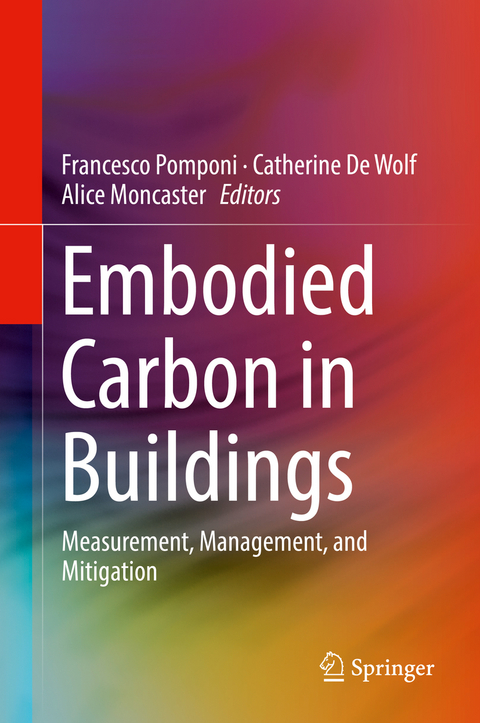
Embodied Carbon in Buildings
Springer International Publishing (Verlag)
978-3-319-72795-0 (ISBN)
This book provides a single-source reference for whole life embodied impacts of buildings. The comprehensive and persuasive text, written by over 50 invited experts from across the world, offers an indispensable resource both to newcomers and to established practitioners in the field. Ultimately it provides a persuasive argument as to why embodied impacts are an essential aspect of sustainable built environments.
The book is divided into four sections: measurement, including a strong emphasis on uncertainty analysis, as well as offering practical case studies of individual buildings and a comparison of materials; management, focusing in particular on the perspective of designers and contractors; mitigation, which identifies some specific design strategies as well as challenges; and finally global approaches, six chapters which describe in authoritative detail the ways in which the different regions of the world are tackling the issue.
Dr Francesco Pomponi is the Vice Chancellor's Research Fellow at the Institute for Sustainable Construction of Edinburgh Napier University. Francesco's expertise lies with life cycle assessment, embodied carbon, and circular economy and he moved to academia after six years in industry as an engineer and project manager. He is part of the newly launched Annex 72 of the International Energy Agency and has recently chaired the 'Life Cycle Assessment and Carbon Accounting' Forum of the International Passive and Low Energy Architecture conference and the 'Design for Sustainability' Track of the International Sustainable Development Research Society conference. He is a Fellow of the RSA, a member of the IET, and an Associate Fellow of the HEA. An associate member of St Edmund's College University of Cambridge and of Cambridge Architectural Research (CAR), Francesco regularly collaborates with practitioners and researchers from South and Central America, South Africa, Europe, and of course the UK. Dr Catherine De Wolf is a Postdoctoral Fellow at the Swiss Federal Institute of Technology in Lausanne (Ecole Polytechnique Fédérale de Lausanne, EPFL) cofounded by the Marie Sklodowska-Curie Postdoctoral Fellowships from the European Commission and a Swiss Government Excellence Scholarship, where she works on low carbon structural design within the Structural Xploration Lab. She also worked as a researcher at the University of Cambridge while obtaining her PhD in Building Technology at the Massachusetts Institute of Technology (MIT), after studying both civil engineering and architecture at the Vrije Universiteit Brussel and Université Libre de Bruxelles. She closely collaborated with leading engineering firms including Arup, Ney & Partners, and Thornton Tomasetti on embodied carbon assessment in buildings. This led to her nomination on the board of the Carbon Leadership Forum and the launch of the Structural Engineers 2050 Commitment Initiative. Dr Alice Moncaster is a Senior Lecturer in Engineering at the Open University. She remains a Visiting Fellow at the University of Cambridge, where she was previously a Lecturer in Engineering and Director of the IDBE masters course, and a Fellow of Newnham College. The move to academia followed ten years in industry as a civil/structural engineer, during which time she became increasingly concerned about the responsibility of the construction sector for climate change. Alice's research focuses on reducing the ecological impacts of the built environment. She led the research group Cambridge University Built Environment Sustainability (CUBES) as part of the Centre for Sustainable Development at Cambridge between 2010-17, and has been the UK participating expert on the International Energy Agency Annex 57, and now Annex 72, since 2012.
Part I - Measurement1. Uncertainty Analysis in Embodied Carbon Assessments: What Are the Implications of its Omission?2. Probabilistic approaches to the measurement of embodied carbon in buildings3. Uncertainty Assessment of Comparative Design Stage Embodied Carbon Assessments4. Embodied Carbon of Wood and Reinforced Concrete Structures Under Chronic and Acute Hazards5. Embodied Carbon of Surfaces: Inclusion of Surface Albedo Accounting in Life Cycle Assessment6. Quantifying Environmental Impacts of Structural Material Choices Using Life Cycle Assessment: A Case Study7. Analysis of Embodied Carbon in Buildings Supported by a Data Validation SystemPart II - Management8. Embodied Carbon Tools for Architects and Clients Early in The Design Process9. Embodied Carbon Research and Practice: Different Ends and Means or a Third Way10. Embodied Carbon in Construction, Maintenance and Demolition in Buildings11. Carbon and Cost Hotspots: An Embodied Carbon Management Approach During Early Stages of DesignPart III - Mitigation12. Applying circular economic principles to reduce embodied carbon13. Embodied Carbon of Sustainable Technologies14. Accounting for Embodied Carbon Emissions in Planning and Optimisation of Transport Activities During Construction15. Design Strategies for Low Embodied Carbon in Building Materials16. Embodied Carbon of Tall Buildings: Specific ChallengesPart IV - Approaches Across Global Regions17. Managing Embodied Carbon in Africa Through a Carbon Trading Scheme18. Embodied carbon in buildings: an Australian perspective19. Current approaches for embodied carbon assessment of buildings in China: An overview20. Embodied carbon measurement, mitigation and management within Europe, drawing on a cross-case analysis of 60 building case studies21. Initiatives to Report and Reduce Embodied Carbon in Buildings in North America22. Embodied and Life Cycle Carbon Assessment of Buildings in Latin America - State-of-the-art and Future DirectionsIndex
"This book is to be welcomed because it brings together a wealth of new knowledge and makes a compelling case for the inclusion of embodied carbon into our thought processes, calculations, practices and governance. It is essential reading and highly recommended to anyone who is serious about reducing the carbon footprint of buildings." (Antonin Lupisek, Buildings & Cities, March 30, 2020)
| Erscheinungsdatum | 18.02.2018 |
|---|---|
| Zusatzinfo | XXII, 512 p. 119 illus., 72 illus. in color. |
| Verlagsort | Cham |
| Sprache | englisch |
| Maße | 155 x 235 mm |
| Gewicht | 958 g |
| Themenwelt | Naturwissenschaften ► Biologie ► Ökologie / Naturschutz |
| Technik ► Bauwesen | |
| Technik ► Elektrotechnik / Energietechnik | |
| Schlagworte | Carbon Management in the Built Environment • Life Cycle Assessment in the Built Environment • Sustainable Building Design • Sustainable Buildings and Environments • Sustainable Constructions |
| ISBN-10 | 3-319-72795-8 / 3319727958 |
| ISBN-13 | 978-3-319-72795-0 / 9783319727950 |
| Zustand | Neuware |
| Haben Sie eine Frage zum Produkt? |
aus dem Bereich


